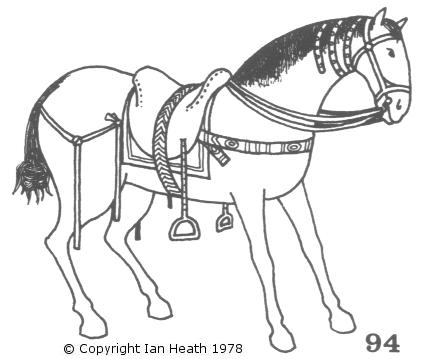BYZANTINE HORSEAn extract from Armies and Enemies of the Crusades 1096-1291by Ian Heath  |
BYZANTINE HORSEAn extract from Armies and Enemies of the Crusades 1096-1291by Ian Heath  |
94. BYZANTINE HORSE
This is typical of Byzantine harness throughout the 11th, 12th and 13th centuries. It appears to have most commonly been dyed red or black.
Horses were mostly from Anatolia and Syria - Anna Comnena mentions Damascene, Edessan and Arab horses being bought for the army, and the Byzantine word for horse (Pharrhi) itself derives from the Arabic. Another type held in high regard for its speed was called the Wild Horse by the Byzantines, apparently the same as the Turcoman or Frankish 'Turqueman' horse. Thessalian horses were also of good quality.
The Byzantines wore their stirrups shorter than the Franks. Spurs are absent from most contemporary illustrations, but they do occasionally occur as, for instance, in one or two pictures in the Scylitzes ms. Some Byzantines (possibly those of Turkish ancestry or extraction) appear to have followed the Turkish custom of controlling the horse by use of a small whip suspended at the wrist.
I know of no Byzantine sources of the Crusade era which depict or mention the use of horse-armour by Byzantines, though this does not prove that it had completely disappeared. It seems more probable that its use simply became less widespread with the gradual deterioration of the military establishment, and that only those wealthy enough (or with access to Imperial armouries) were able to obtain horse-armour after the end of the 11th century or the early part of the 12th century.